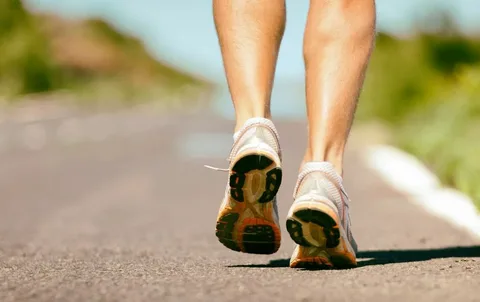Do you suffer from plantar fasciitis? Then you know how much pain and discomfort it can cause. The good news is that several sneaker options can help reduce or even eliminate the pain associated with this condition. This blog post will discuss the best sneakers for plantar fasciitis so you can walk pain-free! We’ll cover the features to look for in a sneak and the best brands on the market today. So if you’re ready to find the perfect pair of shoes to help manage your plantar fasciitis, keep reading!
What Is Plantar Fasciitis?
Plantar fasciitis is a common foot condition that causes pain and discomfort in the heel and bottom of the foot. It occurs when the plantar fascia, a thick tissue band connecting the heel bone to the toes, becomes inflamed or irritated. Various factors, such as repetitive strain or overuse, excessive pronation, or tight calf muscles, can cause this inflammation.
People with plantar fasciitis often experience sharp pain in the morning or after long periods of rest, and the pain may worsen with prolonged standing or physical activity. It is important to seek proper diagnosis and treatment for plantar fasciitis to manage and alleviate the symptoms.
Common Symptoms of Plantar Fasciitis
Common symptoms of plantar fasciitis include sharp pain in the heel and bottom of the foot. This pain is typically most intense in the morning or after long periods of rest, such as when first getting out of bed or standing up after sitting for a while. The pain may also worsen after prolonged standing or physical activity. In addition to heel pain, some people with plantar fasciitis may experience stiffness, swelling, or aching in the foot’s arch.
The pain can range from mild to severe and may feel like a stabbing or burning sensation. It is important to note that the symptoms of plantar fasciitis can vary from person to person. Some individuals may only experience pain in one foot, while others may feel it in both feet. The severity of the pain can also vary, with some people experiencing mild discomfort and others being unable to walk without significant pain.
If you are experiencing any of these symptoms, it is important to consult with a healthcare professional for an accurate diagnosis and personalized treatment plan. Plantar fasciitis can worsen if left untreated, so early intervention is key to managing and relieving the symptoms.
The Importance of Choosing the Right Footwear
Choosing the right footwear can make a huge difference in alleviating pain and preventing further injury when it comes to plantar fasciitis. It is important to select shoes that offer proper support, cushioning, and stability for your feet. Wearing shoes that are too tight or loose can aggravate the condition and cause discomfort, so it is crucial to ensure that your shoes fit properly. Additionally, the materials and construction of the shoe can impact the level of support and comfort it provides.
Investing in shoes specifically designed for plantar fasciitis can help alleviate pain and prevent the condition from worsening. These shoes are designed to provide targeted support to the arch of the foot and reduce pressure on the heel and ball of the foot. It is also important to consider the activity you will engage in while wearing the shoes. For example, if you plan on running, you may need more cushioning and shock absorption than if you plan on walking or standing for extended periods.
Key Features to Look For In Best Sneakers for Plantar Fasciitis
When searching for the best sneakers for plantar fasciitis, there are several key features to look for to ensure maximum comfort and support. One important feature is excellent arch support. The shoes should have a built-in arch support system or be compatible with orthotic inserts to help distribute pressure evenly and reduce strain on the plantar fascia. Additionally, cushioning and shock absorption in the midsole are essential.
This feature helps minimize the impact on the feet and heels, providing added comfort and protection. The midsole should balance firmness for stability and sufficient cushioning to absorb shock effectively. Stability and motion control features, such as a firm heel counter to prevent excessive foot pronation and a wide, supportive base for even weight distribution, are also crucial.
Lastly, a roomy toe box is essential for free movement of the toes, reducing pressure on the plantar fascia. Remember these key features when choosing sneakers for plantar fasciitis to ensure proper support and comfort for your feet.
Tips on Properly Fitting and Wearing Sneakers for Plantar Fasciitis
When managing plantar fasciitis, proper fitting and wearing of sneakers is essential. Here are some tips to ensure you get the most out of your footwear:
- Get fitted by a professional: Visit a shoe store specializing in fitting individuals with foot conditions. A trained professional can measure your feet, analyze your gait, and recommend the best sneaker options for your specific needs.
- Try out multiple sizes and styles: Different brands and models may fit differently, so it’s important to try various options. Walk around in sneakers to assess their comfort and support before purchasing.
- Wear the right socks: Opt for moisture-wicking and cushioned socks that provide additional comfort and protection. Avoid wearing cotton socks as they can retain moisture and increase friction, leading to blisters and discomfort.
- Gradually break into your new sneakers: Avoid wearing your new sneakers for extended periods right away. Instead, gradually increase your wearing time to allow your feet to adjust to the latest footwear.
- Replace worn-out sneakers: Sneakers lose their cushioning and support over time. Replace your sneakers regularly, especially if you notice signs of wear and tear or decreased comfort.
By following these tips, you can ensure that your sneakers fit properly and provide the necessary support to alleviate plantar fasciitis symptoms.
Motion Control and Pronation Support
Motion control and pronation support are essential features to look for in sneakers for individuals with plantar fasciitis. Pronation refers to the natural inward rolling motion of the foot as it strikes the ground during walking or running. However, excessive pronation can strain the plantar fascia, leading to pain and discomfort.
Sneakers with motion control and pronation support features are designed to provide stability and prevent excessive foot pronation. These shoes often have a firm heel counter that helps to stabilize the foot and reduce inward rolling. They may also feature additional support in the midfoot area to promote proper alignment and reduce strain on the plantar fascia.
When shopping for sneakers with motion control and pronation support, look for models specifically designed for overpronators. These shoes often have built-in technologies or support systems, such as medial posts or stability wedges that help correct pronation and provide extra stability. Choosing sneakers with motion control and pronation support features can help alleviate the pain and discomfort associated with plantar fasciitis.
Lightweight and Flexible Construction
In addition to excellent arch support, cushioning, and stability, lightweight and flexible construction is another important feature to consider when choosing sneakers for plantar fasciitis. Lightweight sneakers can help reduce the strain and pressure on your feet, allowing for a more comfortable walking experience. These shoes are typically made with materials that are lighter in weight, such as mesh or synthetic materials. This makes them easier to wear and helps prevent additional fatigue and discomfort.
Furthermore, flexible construction is crucial for individuals with plantar fasciitis. It allows the shoe to bend and move naturally with your foot, promoting proper biomechanics and reducing the risk of strain or injury. Look for sneakers with flexible outsoles that allow for a full range of motion and natural foot flexion. This will help alleviate any restrictions or tightness in the foot, providing added comfort and support.
FAQ’s
1. Can sneakers alone cure plantar fasciitis?
No, sneakers can alleviate the pain and discomfort caused by plantar fasciitis, but it is not a cure. It is important to follow a treatment plan recommended by a medical professional.
2. Are expensive sneakers always better for plantar fasciitis?
Not necessarily. The key features to look for in sneakers for plantar fasciitis are motion control and pronation support, lightweight and flexible construction, and proper fit. Some affordable brands offer these features as well.
3. Can I wear my old sneakers if they feel comfortable?
Replacing old sneakers every 6 to 8 months is recommended, especially if you have plantar fasciitis. Worn-out sneakers lack the necessary support and cushioning needed for this condition.
4. Can walking barefoot help with plantar fasciitis?
Walking barefoot can exacerbate plantar fasciitis by putting pressure on the heel and arch. It is important to wear supportive footwear both indoors and outdoors.
5. How can I maintain my best sneakers for plantar fasciitis?
Clean your best sneakers for plantar fasciitis regularly with mild soap and water. Let them air dry, and avoid using a dryer. Replace the insoles every 6 to 8 months and the sneakers as soon as they show signs of wear and tear.
Conclusion
If you suffer from plantar fasciitis, choosing the right sneakers is crucial. Finding shoes that offer ample arch support, motion control, and cushioning can provide immense relief and help prevent further damage. Remember to prioritize your comfort over fashion, and take the time to try on different shoes to find the right fit. Don’t let plantar fasciitis keep you from enjoying daily activities. With the right sneakers, you can walk pain-free and stay active. Take care of your feet, and they’ll take care of you!
| Other Good Articles to Read |
| Niche Blogs Connect |
| Blogs 97 |
| Blog Stitution |
| Blogs Unplugged |
| Blogs Cotch Rouge |
| Blog Signatr |
| Blog Sintonias |
| Blog Zilla |
| Consumer Forums |
| G Blogs |
| Too Blog |



